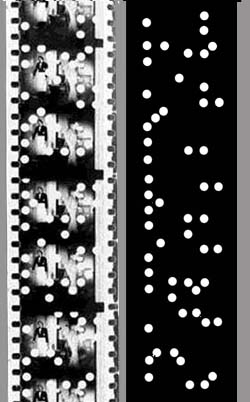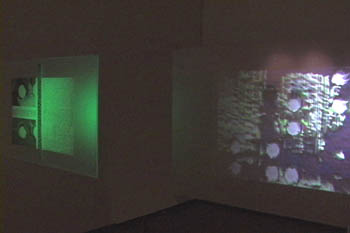
Z1 - Zuse strip
“If the history of
analog cinema officially begins in 1895 with the Lumières, the history
of digital cinema, which yet is to be written, can start in the late 1930s
with German Zuse. Starting in 1936, and continuing into the Second World War,
German engineer Konrad Zuse had been building a computer in the living room
of his parents' apartment in Berlin. Zuse's machine was the first working
digital computer. One of his innovations was program control by punched tape.
For the tape Zuse used discarded 35mm movie film.
One of these surviving pieces of film shows binary code punched over the original
frames of an interior shot. A typical movie scene--two people in a room involved
in some action--becomes a support for a set of computer commands. Whatever
meaning and emotion contained in this movie scene are wiped out by this new
function as data carrier. The pretense of modern media to create simulation
of sensible reality is similarly cancelled: media is reduced to its origin
condition as information carrier, nothing else, nothing more. In a technological
remake of the Oedipal complex, a son murders his father. The iconic code of
cinema is discarded in favor of the more efficient binary one. Cinema becomes
a slave to a computer.
But this is not yet the end of the story. Our story has a new twist--a happy
one. Zuse's film with its strange superimposition of the binary over iconic
anticipates the convergence that gets underway half a century later. Media
and computer--Daguerre's daguerreotype and Babbage's Analytical Engine, the
Lumiere Cinématographie and Hollerith's tabulator--merge into one.
All existing media are translated into numerical data accessible to the computer.
The result: graphics, moving images, sounds, shapes, spaces and text become
computable, that is, simply another set of computer data. In short, media
becomes new media.” (Lev Manovich, Cinema by Numbers)In
the history of experiments in analog cinema, there are many associations of
punch holes and celluloid, ranging from old Brakhage film installations of
Takahiro Iimura.
Punchholes had been the best known synch mark on old work prints and reel
changeover marks in cinema, making the flashing light spots, -visible for
only a fraction of a second- as familiar as the Academy leader .
Manovich establishes a new viewpoint not only to the Zuse strip itself , but
also on the interpretation of works like Iimura’s film installation (and
similar the artworks using mathematical or digitally organized structure for
pure aesthetic reasons)
One might want to use an optical bar code reader that could serves as a digital
“interpretation” of an abstract artwork. (Say, applied on a piece
by Vasarély, Günther Ücker or even Joseph Nechvatal)
Iimura, has produced a work in which the physical intervention on the film
became the only visible feature, interacting with a mere void, whereas Zuse
imposed a different structural pattern on an pre- existing image. Two separate
modes of information, that are interacting with each other.
I am interested indifferent modes of readabiliy - what might be found in Zuse’s
unintended marriage of image and raw code, when these entities would merge
into a fusion.

+zusestrip [Z1] is an investigation
of a direct correspondence between the punched out holes and the surrounding
image of Zuse’s original used cinefilm.
If it would be excavated in thousand of years from now, as an artifact without
knowledge of its context, this punchhole code could very likely be assumed
to have a direct correspondence with the underlying image. The challenge of
a media archeologist might be to find a the key to the correspondence of both
systems.
Similar to the old-media researchers in cypherspace, these efforts
would create a flood of speculations like those on Egyptian hyropgyphics -working
against an infinite universe of language systems.
The movie “Contact “ comes to my mind, and hundreds of similar Science
Fiction stories of cracking the code of the space aliens with lots of “creative”
phantasmatic appearances in which Hollywood script writers envision the language
of higher intelligence.
At this point it is getting quiet ironic, especially if thinks further to
Sigmar, and his written out the command on an early painting with the same
title: '"Higher beings commanded: Paint the upper right corner black!"
Back to Zuse this irony might be conveyed in the effort of using his technical
data as a blueprint for abstract digital image processing.
A re-synthesis of the underlying image, the code applied on parameters responding
to several numeric systems triggering the organization of the pixels, the
way the processed image then appears.
.

Z1 Zuse Strip
Two transparent panels,
36" x 24"
left TEXT (Lev Manovich/ Konrad Zuse)
right VIDEOLOOP (4:50 min)
at DIVERSEWORKS,
Houston Texas, group exhibition WORD curated by Art Jones,
as part of PHOTOFEST 2002, Austin Texas